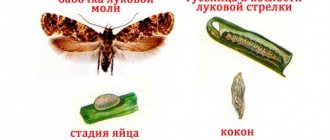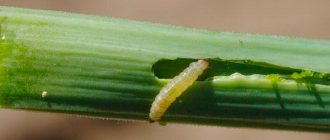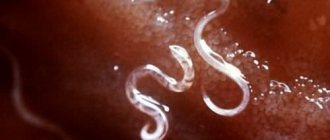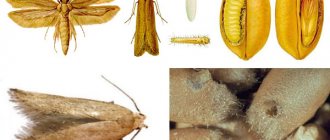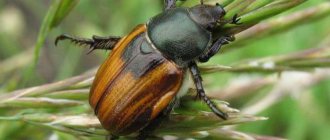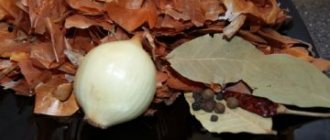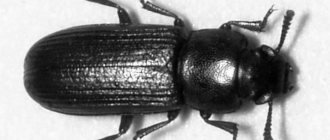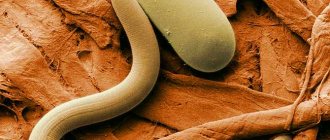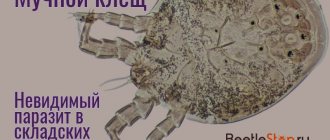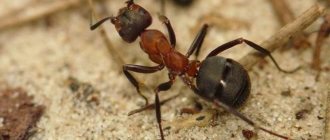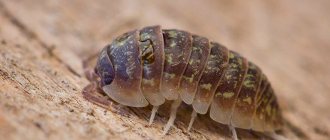The nematode is a common pest that attacks crops of agricultural and ornamental crops, which subsequently leads not only to inhibition of plant development, but also to their death. This is a tiny roundworm that causes enormous economic damage to private and industrial farms. In nature, the onion nematode is most often found, causing rotting of the roots of onions and other varieties of onions, their root system, and stems. Once infected, the crop becomes unfit for consumption, and due to deformation of the protective layer of the bulb, the risk of infection with secondary diseases and infections increases.
Description of the onion pest
The onion nematode is a small round worm with a thread-like white body up to only 1.5 mm long. In the front part of the parasite there is a stylet - a sharp, needle-shaped organ with which it bites into the soft parts of plants and seeds. Their diet consists of onion cell sap and tissue, thanks to the consumption of which they reproduce inside the vegetable and lay larvae. In one season, a female is capable of laying several hundred eggs, and under favorable conditions, up to 6 generations of new individuals can develop from them. As the population increases, damage to crops becomes more severe, and further development of the worm may continue even after harvest.
The onion nematode is one of the most common parasites throughout the world. The greatest distribution of this worm is found in regions with temperate climates. During infection, the parasite can destroy up to 80% of the entire crop.
In addition to onion nematodes, other varieties of this pest can be found in agricultural areas. Typically, this type of worm affects plantings of garlic, carrots, potatoes and legumes.
Life cycle
Like most roundworms, the onion nematode is a migratory parasite. Throughout their lives, they constantly change their owner, causing him enormous damage, even complete destruction.
The initial development of the nematode occurs in the egg, which the adult female lays in the plant or soil. After a short period of growth, the first moult occurs - the larva emerges from the egg and begins to feed on the surface part of the rhizome, the internal part or the sap of the plant. The development process takes up to 1.5 months, during this period the young individual molts 4 times, moving from one stage to another. After reaching sexual maturity, the female mates with the male and lays larvae in the most comfortable conditions for development.
Read about the root system of onions here.
One life cycle of the nematode occurs within 4-8 weeks, during which time hundreds of other larvae appear, capable of destroying the entire onion planting. The most comfortable conditions for the development of the worm are moderately moist soil with a temperature of 15-20 degrees, and during cold weather the onion nematode goes into suspended animation on the surface or inside the plant, in the soil, without showing any signs of life. The worm can remain in this state for up to 5 years.
All stages of nematode development take place in one plant; the soil is only a temporary habitat. One bulb can simultaneously contain up to 15 thousand individuals, feeding on the juices and tissues of the host.
Nutrition process
Once inside or near the plant, the worm pierces its tissue with a stylet and, with the help of its digestive enzyme, begins to feed on the life sap. Under the influence of this substance, the normal development and functioning of the rhizomes and stem in the plant is disrupted, which over time leads to complete inhibition of growth and death. Nematodes are selective in their choice of food; they cannot live in dead or weak tissue, so after completely destroying one bulb, they move to another. Due to such constant migration, the entire crop is destroyed.
The harmfulness of the parasite
The most dangerous pests of garden crops are small nematode worms. Parasites are distinguished by their gluttony, eating the crop from stem to rhizome. The result of worm pests in the garden is:
- poor plant germination,
- stem deformation;
- development slowdown;
- poor harvest or lack thereof.
Parasitism by worms leads to the development of fungal infections and putrefactive diseases.
The pest easily moves from an infected vegetable to a healthy one, so you should carefully sort the fruits before placing them in storage. Important! If the storage rules for onion crops are not followed,
nematodes continue to grow and develop.
Signs of defeat
Worm infestation can be detected at almost any stage of plant development. Nematode damage to onions can be seen by external signs:
- The leaves and stem are underdeveloped and practically do not grow;
- The bulbs have a loose and rotten structure;
- The foliage dries out and does not respond to watering, its color changes;
- The onion peels fall off, there are cracks throughout the entire area;
- The bottom falls off or becomes very soft.
Spread of the nematode through the irrigation system
When infected in the early stages, the first leaf appears swollen and twisted. As the plant grows, these changes become more pronounced. Later, infection is much more difficult to detect; whitish spots appear on the bulbs, and the peel scales become thicker and fleshier. Due to the active life of the worm, the white color of the tissues changes over time to gray or dark brown. Pronounced cavities appear between the scales, and the fruit itself becomes soft and friable. The foliage appears weak, yellower and characteristically curls under its own weight.
Damage caused
How does the onion nematode feed?
The insect pierces the plant tissue with its stylet, introduces digestive enzymes into it and then sucks out the juice. Nematode enzymes disrupt the normal development of onion stems and rhizomes affected by this pest. Over time, the parts of the plant most densely populated by parasites are destroyed. These worms are very sensitive to the quality of food. Since nematodes cannot live in dead tissue, they leave the dead area and move to the neighboring one.
Signs of plant damage
Infection of plants with onion nematode is indicated by external signs such as:
- underdevelopment and deformation of leaves, their yellowing and drying;
- loosening of the bulb, its cracking; As the disease develops, the bottom becomes rotten, it falls off, and the bulb is completely destroyed.
In an onion that has been subjected to early infection by a nematode, the first leaf that appears is curved and swollen; later, as it grows, the curvature of the leaves and thickenings, located mainly in their lower parts, become more and more noticeable.
If the seedlings were infected at a later stage of development, the diseased plants may be almost indistinguishable from healthy ones, but white spots often appear on the bulbs.
By cutting these bulbs, you can see granular, loose, fleshy scales that are unevenly
thickened. In the initial stage of the lesion they are white, and later acquire a gray or brown color. Cavities form between the inner scales, the bulb becomes soft to the touch, and its bottom and sides may crack.
If the onion nematode colonizes garlic, its false stem thickens and cracks. The leaves curl, bend in waves, dry out and turn yellow. The bulb loosens and becomes damp to the touch, its bottom may become rotten and fall off.
How it harms plants
The result of infection of plantings by onion nematode is a significant reduction in yield. Plant diseases caused by nematodes lead to:
- delayed emergence of seedlings;
- slowing down the growth of seedlings;
- partial death of the plant; Severely affected seedlings die completely.
The nematode damages the roots, violating their integrity, as a result of which pathogenic bacteria and fungi penetrate the plant. Also, seedlings infected with this worm have reduced resistance to other pests, such as hoverflies, mites, and onion flies.
Diseases of onion and garlic plantings caused by nematodes reach their greatest development towards the end of summer, in August or early September.
Nematode-infected bulbs continue to rot in storage. This process goes faster if the room temperature is high. A significant portion of diseased bulbs become unusable as a result. At the same time, in a storage facility with a high level of humidity, the nematode is able to crawl from diseased bulbs to uninfected neighboring ones.
How to get rid of worms
The fight against nematodes in a commercial or home garden is a complex procedure, since the worm can remain in the soil for a long time without showing any activity. However, infection most often occurs when favorable conditions occur and there is a sufficient population of the parasite in the area. To combat nematodes you need:
- Annually change vegetable or ornamental crops for cultivation on a specific plot of land;
- Carry out careful selection and processing of seed material;
- Use chemicals;
- Follow the rules for storing crops.
Read this article about why onions rot during storage.
When crops are infected with nematodes, the most effective method of control is the use of chemicals that affect the worm at any stage of development.
Preparations for processing onions
The most popular and reliable means for destroying the nematode population is percalcite. This is an oxygen-containing preparation that is usually used as a fertilizer, but can also be used to control pests. It allows you to destroy not only mature worms, but also nematode cysts with eggs and parasite larvae. The product should be used only in dry weather over the entire sown area 7 days before planting. Percalcite should be used at a rate of 250-300 g/m2. Carbamide is often used to kill onion nematodes . It must be added to the soil a month before sowing at a rate of 100 g/m2. In rare cases, ammonia water is used, which, in addition to pest control, helps replenish nitrogen in the soil (it is recommended to use it at a rate of 250 g/m2).
Traditional ways to get rid of onion nematode
Some gardeners prefer to fight the parasite without using chemicals. According to research, the use of traditional methods is ineffective, since it destroys only a small part of the nematode population. The following methods are usually used:
- Planting material (sets or seeds) must be filled with hot water at a temperature of 45 degrees for 1 hour. After complete drying, the bulbs can be planted in the ground;
- To disinfect the seed, it can be left for 2 hours in an infusion of wood ash. Before planting, seeds or sets must be thoroughly dried;
- 10 hours before planting, the bulbs can be heated at a temperature of 42-45 degrees.
- 1 day before planting, the sets or seeds should be soaked in a solution of potassium permanganate or formaldehyde. Some farmers recommend using a 1% brine solution.
Despite the low effectiveness of traditional methods of fighting nematodes, they can be used to prevent infection in the area. The methods described above can help avoid severe infection, thereby saving part of the crop.
Preparing storage before harvest
The onion stem nematode prefers a moist environment; it is recommended to avoid excessive dampness indoors. Before storing vegetables, it is possible to treat the storage with sulfur dioxide (50 g/m3). People are allowed to visit the warehouse 24 hours after processing.
Warehouse preparation measures:
- before planting the crop, pallets and equipment are removed from the premises; if there is access to the street in warm weather, ventilation is carried out for a week;
- wash the equipment in soapy water and dry in sunny weather;
- if there is mold, treat the walls with lime with the addition of copper sulfate.
Preventive measures and their importance
Preventing crop infection by parasites is one of the most reliable ways to maintain plant health and prevent infection. With regular treatment of the area, you can reduce the risk of onion nematodes to almost a minimum.
The following methods are recommended as preventive measures:
- You should regularly change the planting location of any ornamental or agricultural crop. Alternating planting helps not only protect the crop, but also improve the condition of the soil;
- Seed material in any form must be processed before planting. This may be exposure to hot temperatures or chemicals. Read the link to learn how to grow onions from seeds;
- After harvesting, it is important to destroy all plant debris, especially weeds and diseased plants. After digging the onions, the soil should be dug up and inorganic fertilizing should be applied;
- If an area is infected with onion nematodes, it is necessary to use an effective chemical agent, since traditional methods can destroy only part of the pest population;
- It is necessary to observe the rules and conditions for storing the onion crop (humidity, light and temperature). Worm larvae can stay in the plant for a long time, so they are able to activate after a long time when they are in comfortable conditions.
Read this article on how to store fresh cucumbers.
Proper prevention will not only protect your harvest, but can also reduce the risk of infection with other parasites. If you regularly treat the area and treat it before planting and monitor crop rotation, the risk of pests will be minimal.
Infection of onions with nematodes increases the chances of the plant becoming infected with fungus and other dangerous diseases that enter the plant through the soil.
Notes[edit | edit code]
- ↑ 1234
Nematodes / G. A. Platonova // Morshin - Nikish. - M.: Soviet Encyclopedia, 1974. - (Great Soviet Encyclopedia: [in 30 volumes] / chief editor A. M. Prokhorov; 1969-1978, vol. 17). - ↑ 1 2 3 4 Hodda, Mike.
Phylum Nematoda Cobb 1932 (English) // Zootaxa. - 2011. - No. 3148. - P. 63-95. - ↑ 1 2 Lambshead PJD
Recent developments in marine benthic biodiversity research // Oceanis.
- 1993. - Vol. 19
(6). - P. 5-24. - ↑ Nematoda from the terrestrial deep subsurface of South Africa: Nature: Nature Publishing Group (unspecified)
. Access date: June 13, 2011. Archived September 20, 2011. - ↑ 1234
Collier's Encyclopedia, 2000. - ↑ 12
Nematodes // Biology. Modern illustrated encyclopedia / Ch. ed. A. P. Gorkin. - M.: Rosman, 2006. - 560 p. — (Modern illustrated encyclopedia). — ISBN 5-353-02413-3. - ↑ Poinar GO et al.
Earliest fossil nematode (Mermitidae) in Cretaceous Lebanese amber // Fundam. appl. Nemawl. - 1994. - No. 475-477. - ↑ Gubanov N.M.
Giant nematode from the placenta of cetaceans -
Placentonema gigantissima
nov. gen., nov. sp // Reports of the USSR Academy of Sciences. - 1951. - T. 77, No. 6. - P. 1123-1125. Archived from the original on April 12, 2022. - ↑ 123
Biological encyclopedic dictionary, 1986. - ↑ Nematodes gain experience as they grow - Neuroscience (unspecified)
.
Portal “Attic: science, technology, future”
. chrdk.ru. Access date: January 10, 2022. - ↑ Smith H.
Sperm motility and MSP // WormBook. - 2006. - doi:10.1895/wormbook.1.68.1. - ↑ Yushin V.V., Malakhov V.V.
Origin of nematode spermatozoa: progenesis at the cellular level // Biology of the sea. - 2014. - No. 40. - P. 83–94. - ↑ 1 2 3
BG Chitwood, 1957, Phylum name.
(undefined)
. Access date: February 22, 2011. Archived November 29, 2012. - ↑ 123
Malakhov, 1986. - ↑ Key to parasitic nematodes. T. 1. Spirurates and filariates / Ed. K.I. Scriabin. - M.-L.: Publishing House of the USSR Academy of Sciences, 1949. - 520 p. — P. 243.
- ↑ Zoology of invertebrates. T. 1: From protozoa to mollusks and arthropods / Ed. V. Westheide and R. Rieger. - M.: KMK, 2008. - iv + 512 p. — ISBN 978-5-87317-491-1.
- ↑ Margulis L., Chapman MJ.
Kingdoms & Domains: An Illustrated Guide to the Phyla of Life on Earth. 4th ed. - Amsterdam: Academic Press, 2009. - 659 p. — ISBN 978-0-12-373621-5. - P. 274. - ↑ Stichosomida (English). ucdavis.edu. Date accessed: August 7, 2017.
- ↑ 1 2 Nematodes
- article from the Great Soviet Encyclopedia. - ↑ Nematodes // 1. Small medical encyclopedia. — Medical encyclopedia. 1991–96 2. First aid. — Great Russian Encyclopedia. 1994 3. Encyclopedic Dictionary of Medical Terms. — Soviet encyclopedia. - 1982-1984 (Russian). - M.
- ↑ Nematode plant diseases
- article from the Great Soviet Encyclopedia. Sveshnikova N. M.. - ↑ 1 2 Sharova I. Kh.
Zoology of invertebrates.
conclusions
Onion nematode is a small type of parasite that can lead to complete destruction of the entire crop and serious contamination of the soil. The worm can remain in the soil or seed for a long time, so preventive measures are an important requirement (of great importance) to maintain the health of the soil and plants. When onions are infected with nematodes, it is recommended to use effective chemicals and completely destroy all affected stem roots. In addition to the nematode, the onion fly is also common, which you can read about here.
Downy mildew (peronospora)
Downy mildew (peronospora)
The causative agent of the disease, the fungus Peronospora, affects onions during the growing season. The disease is especially dangerous for onion seeds in wet years.
The fungus overwinters in the form of a mycelium in the bulbs, without outwardly manifesting itself in any way. Can overwinter in plant debris. The mushroom enters the garden with infected bulbs planted in the ground. During the first 20-30 days, plants develop from infected bulbs without any external manifestations of the disease. However, along with the onion, the mycelium also grows. It penetrates into the leaves through the intercellular spaces. The disease appears on the leaves in the form of round, blurry yellowish spots, on which, in wet weather, a gray-violet coating of summer fungal spores appears. Sick plants are stunted, wilt, turn yellow, and may die. In dry weather, the development of the disease stops.
Wind and rain disperse the spores, infecting healthy plants. Once on a healthy plant, the spore grows into a mycelium, which penetrates into the tissue of a healthy leaf through stomata. After 10-15 days, a yellow oval spot with a coating of spores forms on the leaf at the site where the mycelium invades. Diseased leaves dry out. Later, the mycelium penetrates from the leaves into the bulb, where it will overwinter.
On onion seeds, the fungus infects the shoots, which turn yellow and break. In this case, the seeds on the inflorescences are either not formed at all or are formed puny. Perennial types of onions (batun, leek, chives) are a constant source of spore formation. The mycelium overwinters in their roots.
Measures to combat downy mildew (peronospora) on onions and garlic
- Rotation of crops: onions should return to their original place after 3-4 years. Planting onions in open areas well blown by the wind.
- If possible, remove nigella crops from other onion crops.
- Crops of perennial onion species should be isolated as much as possible from other onion plantings.
- Planting onions with bulbs not infected with peronospora.
- Removing diseased plants or diseased leaves during the growing season.
- Spraying seed plants and other onion plantings, except for onion plantings, with 1% Bordeaux mixture, oxychome or copper oxychloride. The period of spraying is at the first manifestation of the disease.
- Disinfection of planting material in one of the following ways: a) heating onion sets, turnips, samples obtained from infected crops at a temperature of +40... +43° C for 16 hours or at a temperature of +35... +37° C for 7 days . It is better to warm up the sets in the spring 12-14 days before planting; b) warm up the planting material at a temperature of +40° C for 8 hours, and large bulbs for 16 hours. In this case, the mycelium in the bulbs dies.
- Drying the onions in the garden until the leaves are completely dry and dry covering scales form on the bulbs. Removal of crop residues.
Structural features
The body length ranges from 80 microns to 8.4 m (this is the length of the parasite Placentonema gigantissima
, living in the placenta of the sperm whale).
Females are slightly larger than males. The body of nematodes is unsegmented, has a filamentous or spindle-shaped, less often (in females) barrel-shaped or lemon-shaped. In cross section, the body is round (hence the name roundworms
); at the core, it has bilateral (two-sided) body symmetry with biradial elements. The anterior end of the body (head) also shows signs of triradial symmetry.
Roundworms have a developed skin-muscular sac. The body is covered with a smooth or ringed cuticle, under which is the hypodermis, and under it are cords of longitudinal muscles. Along the circumference of the body, the hypodermis forms 4 ridges (“chords”) protruding into the body cavity - dorsal (dorsal), ventral (abdominal) and two lateral. Nerve trunks pass inside the dorsal and abdominal cavities, and sensory nerves and excretory canals pass through the lateral cavities.
In parasitic forms, the epithelium can acquire a syncytial structure, that is, there are no cell boundaries in it, and it consists of a cytoplasmic mass with nuclei included in it. The nuclear-containing part of the epithelial cells is connected to the surface syncytial layer by cytoplasmic bridges. In parasitic forms, glycogen necessary for glycolysis can be stored in the hypodermis. Under the hypodermis there is a layer of longitudinal muscles, divided by the hypodermal ridges into 4 strands.
Diagram of the body structure of a (hermaphroditic) nematode: 1 - anterior end of the body, bearing a mouth; 2 - intestine; 3 - cloaca; 4 - excretory system; 5 - testis; 6 - nerve ring; 7 - dorsal nerve; 8 - ventral nerve trunk; 9 - excretory opening.
Between the skin-muscular sac and the internal organs of the body in more or less large forms there is a primary body cavity - a pseudocoelum, which differs from the secondary (coelom) by the absence of an epithelial lining. In small marine nematodes, there is virtually no body cavity, and the slit-like space between the body wall and the organs is filled with an extracellular matrix.
With the exception of some sensory organs, nematodes lack flagellar cells. The circulatory and respiratory systems are absent.
Digestive system
The digestive system of roundworms is like a tube, continuous. It begins with the oral cavity, passes into the esophagus, then into the anterior, middle and ends with the hindgut, which opens at the posterior end of the body from the abdominal side. In several parasitic orders, the intestine is transformed into a trophosome without a lumen. The oral opening is terminal or rarely shifted to the ventral or dorsal side. The mouth is surrounded by lips and leads into a muscular pharynx. The pharynx has a triangular lumen, which expands with the contraction of radial muscle fibers, and is used for sucking in food. It has a complex structure and in many groups of predatory and parasitic nematodes carries a variety of weapons. The pharynx opens into the midgut, which is endodermal in origin. The digestive system ends with the hindgut, which opens into the anus in females and the cloaca in males. Nematodes feed mainly on bacteria, algae, and detritus; There are also predators among them, many are parasites of animals, fungi and plants.
Excretory system
It is assumed that the main organs of the excretory system of nematodes are a unicellular (or less often two- or multicellular) cervical gland, or lateral intracellular canals (renettes), and large pseudocoelomocyte cells. Renetta has a voluminous body and has an excretory duct, opening outward with an adjustable pore. Pseudocoelomocytes do not have ducts; they isolate and utilize metabolic products. In addition, ammonia can be released from the body of nematodes by diffusion through the body wall.
Nervous system
The nervous system consists of a peripharyngeal nerve ring and several longitudinal nerves. The nerve ring is located at the level of the middle of the pharynx and is inclined with its dorsal edge forward (in some groups the inclination is reversed). In its structure, the nerve ring is a single circular ganglion and, apparently, serves as the main associative organ. The ventral nerve trunk and dorsal nerve originate from it; the remaining longitudinal nerves are not directly connected to it. The ventral nerve trunk contains the bodies of neurons; other longitudinal nerves do not have bodies and are bundles of processes of neurons of the ventral trunk. All longitudinal trunks pass intraepithelially - in the ridges of the hypodermis. The sense organs are represented by numerous sensilla: tactile setae, labial papillae (papillae), complementary organs of males, olfactory amphids and sensory glandular organs - phasmids. At the posterior end of the body of free-living nematodes there are terminal tail glands, the secretion of which serves to attach to the substrate. These sensory organs are mechano-, chemo-, or less often photoreceptors or have mixed sensitivity and are always associated with glandular cells. The main organs of long-range chemical reception are amphids - complexly arranged paired organs at the anterior end of the body, having a variety of shapes. Other sensory organs of the head include the cephalic sensilla, subordinate in their arrangement to radial symmetry and located in three or two rows. Some free-living nematodes, in addition, have internal mechanoreceptors - metanemes.
Sexual dimorphism
The overwhelming majority of nematodes have distinct external sexual dimorphism and are dioecious, but hermaphrodites are also known. Nematodes lay eggs and, less often, are viviparous. Fertilized eggs hatch into larvae. This occurs in the external environment or even in the female genital tract (ovoviviparity). In males, the posterior end of the body is curved to the ventral side and has a complex copulatory apparatus. The role of holding the female during copulation is played by various complementary organs and (in rhabditid nematodes) bursae. Sperm are introduced using spicules that extend from the cloacal opening. The internal genital organs in the original version are paired and have a tubular structure. Females have a single or double set of ovary, oviduct and uterus; the vagina is always the only one. Males have one or two testes with vas deferens and an unpaired ejaculatory duct. Nematode sperm have an extremely diverse structure, lack flagella and have amoeboid (but not actin) motility.
Development cycle
Development occurs without metamorphosis. In the most general case, there are 4 juvenile stages and one adult stage in the life cycle. The transition between stages occurs during the molting process. Since some molting may occur in the egg membranes, the number of free stages can be reduced. In rhabditid nematodes, the so-called The dauer stage is a modified third juvenile stage that plays a dispersal role and survives unfavorable environmental conditions.
Prevention
To prevent the invasion of nematodes on plants, it is necessary to adhere to preventive measures when planting and caring for strawberry beds. The nematode can get into the beds when transporting seedlings. As a result, when purchasing seedlings, it is necessary to carefully check the roots of the plants. They should be without unnecessary inclusions. To be absolutely sure that there are no nematodes, you need to keep the seedlings in boiled water before planting. Parasitic worms die at temperatures above 40 degrees, and warm water will only be beneficial for seedlings.
When choosing seedlings, you should prefer more resistant varieties, such as “Raketa” and “Granddaughter”. When planting, care must be taken to disinfect the seedlings. This procedure is carried out with a solution of Parathion. Before planting, new compost containing fungi harmful to parasites is added to the soil. To prevent nematodes from entering strawberry bushes, the plants must be transplanted to another area every 4 years.
Near the strawberry bed you need to plant calendula, marigolds, and nasturtium. The root system of these plants is capable of releasing liquid into the ground, which is destructive for strawberry nematodes. Also, as a preventive measure, you can dig a shallow hole around the bed and put lime there, which helps repel the invasion of worms.
See below for ways to combat strawberry nematode.
Ways to repel mole crickets
Mole crickets love warmth and dampness, so they try to get into manure or compost heaps. Such heaps should be fenced off with sheets of metal or slate, dug to a depth of at least 50 cm.
Mole crickets can be scared off in the following ways:
- plant the beds around the perimeter with marigolds, chrysanthemums or calendula;
- Place pine, spruce or larch needles on the paths;
- Every one and a half to two meters, stick an aspen or alder peg made of fresh wood into the ground. Change pegs as they dry;
- as a preventive measure, before planting tubers, throw a little onion peel or a crushed clove of garlic into each hole; before planting, water the beds with a weak solution of iodine (20 drops per bucket of water);
- Be sure to add an infusion of onion peels to the liquid for watering potatoes;
- chop small fish or the insides of regular fish. The resulting mass can be used fresh or left in a closed container for several days to allow it to spoil (not all people can tolerate this smell). Before planting the tubers, put a little fish mush in each hole and sprinkle with soil.
What to do if a worm eats an onion, how to treat it, folk remedies
The benefits of onions for the human body are undeniable. The vegetable has a number of useful substances.
People have been growing this crop in their gardens for a long time. This is an unpretentious plant that is resistant to various fungi. The onion fly and its larvae cause a lot of trouble to gardeners. When a worm eats an onion, there are several ways to treat it: folk remedies and industrial preparations can provide a positive result.
Trichodermin
At the stage of detecting onion worms, you cannot hesitate. In this case, it is advisable to use the drug Trichodermin.
Before use, you should carefully study the instructions and recommendations from the manufacturer on how to get rid of the pest. The solution is prepared in the following proportions: take 3 liters of water per 3 g of substance.
The prepared mixture must be treated with the plants. Watering is not recommended immediately after spraying, so as not to wash off the active product from the feather.
After 10 days, the culture is sprayed again. If larvae reappear, additional treatment is necessary.
Metronidazole
This medicine in tablets can be purchased at the pharmacy. The product has antimicrobial and antibacterial effects. Before use, it is worth learning how to properly prepare a solution for processing the garden.
The drug is effective against onion flies, nematodes, and a number of similar pests. Removing insects is sometimes difficult; various antiparasitic methods and control methods are used for these purposes. Metronidazole has proven itself as an effective treatment for various vegetable crops.
A solution is prepared for spraying. 4 tablets are dissolved in 10 liters of water. The beds are watered with liquid. The solution can also be sprayed. If the damage to plants is large-scale, it is recommended to repeat the procedure after 10-15 days.
Ammonia
Ammonia is widely used for processing onion heads. Its pungent smell repels insects from tubers and foliage.
It is not difficult to prepare the solution. To do this, you should prepare 10 liters of settled water and dilute 60 ml of ammonia in it.
Repeated treatment can be carried out no earlier than a month later. Ammonia tends to erode and be washed out of the soil, so you can carry out the procedure 2 times per season.
Dandelion decoction
Dandelion can permanently remove harmful larvae and insects from the garden, but first you need to properly make a decoction of it.
Preparation will take several days, since the solution must infuse for a long time. For the tincture, you need to take 200 g of finely chopped dandelion root and pour 1 liter of boiling water. The mixture is infused for exactly 2 days. Then the solution is brought to a volume of 10 liters by adding water to it. Spraying with infusions gives excellent results if used in conjunction with salt solutions.
Step-by-step instruction
The fight against armyworms has a number of characteristic features that need to be taken into account depending on the age of the individuals.
How to fight butterflies?
HELP: If the above methods do not bring the desired result, it is necessary to use chemical insecticides.
Adult cutworms lay larvae on plants, which soon begin to devour leaves and young shoots. Basic methods of controlling butterflies:
- Use of pheromone traps. These devices show the gardener and gardener the exact time of appearance of butterflies and, accordingly, caterpillars;
- Fighting butterflies with the help of their natural enemies - bracon and trichogramma;
- Using proven folk recipes;
- Digging up soil in the fall, since cutworms overwinter in the soil;
- Biological products against insects.
The easiest way to protect cabbage from pests: the gnawing cutworm:
How to get rid of armyworm caterpillars?
The fight against armyworm caterpillars has its own characteristics. The main methods include:
- Deep digging of the soil in the spring in order to reduce the number of overwintered armyworms;
- Elimination of weeds - these plants serve as the main basis for feeding the larvae;
- Manual collection of the first larvae and caterpillars;
- Use of folk remedies;
- Use of biological products;
- Treatment of plants with chemical insecticides;
- Autumn digging of soil to destroy individuals that remain for the winter.
Garlic stem nematode: control with chemical and folk methods
Chemicals should be used when plants are massively infected. In this case, it is necessary to use effective soil treatment agents:
- Carbation. Dosage: 200 ml per sq. m. Recommended for use in August;
- Tiazon. 250 gr. per sq. m, mixed with sand in a ratio of 1:3;
- Formalin at a concentration of 1:25. 5 l per 1 sq. m, used in September;
- Peracetic acid (hydrogen peroxide). 5 l per 1 sq. m. The drug is used in September and October;
- Vidat. 1-2 gr. added to each hole when planting seedlings in open ground.
If 1-2 plants are affected or primary signs of the appearance of a parasite are detected, one of the traditional methods can be used.
Tobacco decoction
You need to take 500 g of dry tobacco and mix it with 12 liters of warm water. Next, boil the mixture for 2 hours. The decoction must be cooled and the plant treated with it.
Anti-nematode remedy from calendula root
To prepare the mixture, you need to take 500 g of ground calendula root (you can buy it in specialized stores, or prepare it yourself). The ground mass is placed in an enamel bowl, filled with 15 liters of water, put on fire and brought to a boil.
Afterwards, lower the temperature so that the broth does not run away, and boil for another 15-20 minutes. The finished product is cooled, filtered and used for processing by spraying.
Traditional methods are less effective and can affect the parasite only in the first stages of development, or if they are used in parallel with potent chemicals.
